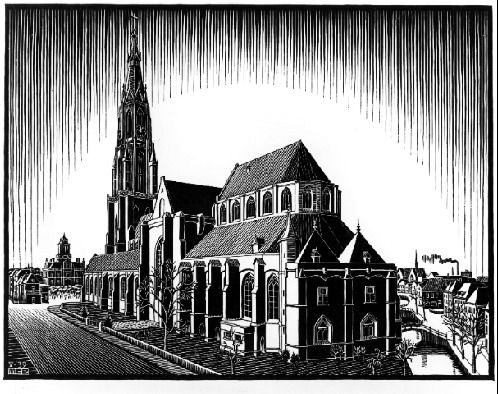Maurits Cornelis Escher (M.C. Escher) and Delft
Maurits Cornelis Escher (1898–1972) is one of the world’s most famous graphic artists, known for his intricate and mathematically inspired prints. Although born in Leeuwarden, Escher had a notable connection to Delft that influenced his early academic and artistic development.
Escher’s Time in Delft
Escher enrolled in 1918 at the Technical College of Delft (now TU Delft) to study architecture. However, his studies there faced challenges, partly due to health issues and difficulties with the curriculum. With the advice of a professor, he shifted his focus toward graphic arts, leading him to pursue an artistic career rather than architecture.

Though his architecture course in Delft was not a success, the city played a key role in Escher’s formative years. About 20 years later, Escher made an important artistic contribution to Delft through a government commission.
Woodcuts of Delft
In December 1938, Escher received a government commission to create ten woodcuts depicting various views of Delft for a book publication. Although the book was never published, Escher produced the woodcuts, which remain unique as the only series he made focusing on a Dutch city.
In spring 1939, Escher frequently traveled by tram from his parents’ home in The Hague to Delft. He explored the city, making drawings of major landmarks such as:
- Oostpoort (the eastern city gate),
- Nieuwe Kerk (New Church),
- Oude Kerk (Old Church),
- Town Hall,
- and the Markt (marketplace).

With rare permission, Escher even climbed the tower of the Oude Kerk to gain higher vantage points. These sketches were then transformed into woodcuts during the summer of 1939 in Ukkel, Belgium.
Two notable woodcuts from this series include views of:
- The Grote Markt (central square) seen from the Nieuwe Kerk tower,
- The Renaissance-style Town Hall viewed from the south.

Legacy and Recognition
Though Escher is best known for his impossible constructions and mathematically inspired work, these Delft woodcuts represent a special part of his oeuvre, capturing the historic urban character of the city. They highlight Escher’s skill with architectural subjects and his meticulous approach to detail.
Today, these woodcuts are appreciated by both art lovers and Delft locals as a unique artistic homage to the city. They contribute to the cultural heritage of Delft and reflect the lasting connection between Escher and the city’s historic environment.
If desired, the woodcuts can be viewed in museums or as reproductions linked to Delft’s art history.
